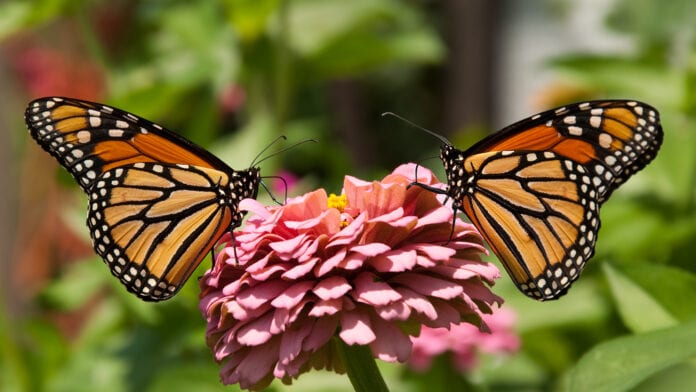Where have all the butterflies gone?
Butterfly species hard hit by changeable weather patterns.
Where have the butterflies gone? Butterfly Conservation launches this year’s Big Butterfly Count with urgent appeal for public’s help after disastrous spring weather.
Chris Packham and wildlife charity Butterfly Conservation are launching this year’s Big Butterfly Count today by asking people to help find and record butterflies across the UK.
Butterfly Conservation’s current records show that many species of butterflies have had a poor spring or a delay in their emergence following 2021’s unseasonably cold and wet weather. The Speckled Wood was particularly low in numbers this spring, but the Small Tortoiseshell, Comma, Green-veined White, Large White and Red Admiral were also all down in abundance compared with their 10-year average. How this will impact this summer’s butterflies is what the charity is asking people to find out, by taking part in the Big Butterfly Count.
The weather in spring 2021 has been very challenging for many of the UK’s butterflies and moths. Although April was the sunniest on record, it was also very cold with a record number of frosts. This was then followed by the wettest May for over 50 years. Butterfly Conservation needs the public’s help to measure how these conditions have affected our butterflies and moths.
The UK is experiencing an increasing number of extreme weather events, a likely result of climate change, and it’s important we learn the effect these changes have on our native butterfly species in order to understand the likely long-term impacts on biodiversity.
The Big Butterfly Count is Butterfly Conservation’s annual three-week citizen science event. The UK-wide survey is open to everyone, of any age, living in towns, cities or the countryside. Taking part just requires you to spend 15 minutes in an outdoor space (a great staycation activity) counting the amount and type of butterflies, and some day-flying moths, you see. It is easy to do and the more people who do it, the greater the benefits to our understanding of nature and how to help it.
There were over 145,000 counts submitted to the Big Butterfly Count last year, more than ever before. Though worryingly, 2020 also saw the lowest average number of butterflies logged since the event began twelve years ago. Butterfly Conservation scientists are keen to see if this is a trend that continues in 2021. This means it’s more important than ever that the public take part and help to gather the data needed.
In Wales there were 50,412 individual butterflies and moths counted during the 2020 Big Butterfly Count. A total of 5,196 counts were undertaken by 4,124 participants.
Chris Packham, Vice-President of Butterfly Conservation and wildlife broadcaster, says: “Biodiversity and climate crisis is an urgent issue and it can be overwhelming to think about what we can do as individuals to really make a difference. Because butterflies and moths make excellent indicators of the impacts of climate change and other human environmental factors, collecting data on their numbers is really important. So, something as simple as recording a butterfly spotted in your garden, at your local park or on your window box can play a part in vital research into a global problem. It’s a really valuable contribution everyone can make.”
Dr Zoë Randle, Senior Surveys Officer at Butterfly Conservation says: “The Big Butterfly Count, along with our other research work, is already showing us changes in the populations of our butterflies and moths. Climate change and other human-led impacts are causing some species to be found in new areas, while others are becoming harder to find in the UK at all. An example is the Jersey Tiger, a really striking moth that flies during the day as well as at night. These moths have been well-established along the south coast of England but are moving further north and are now found in ever increasing numbers in other areas. As a result, the Jersey Tiger appears on this year’s Big Butterfly Count identification chart for the first time.
“We really need the public’s help to understand what is happening to our butterfly and moth populations. It’s a small but crucial thing everyone can do. This information will not only help us to protect these species, but also to inform what effect the changing climate is having on our biodiversity.”
Taking part in the Big Butterfly Count is something anyone of any age or ability can do, in any outdoor space. It provides a real contribution to science and our understanding of butterfly and moth populations in the UK.
This year the Big Butterfly Count is sponsored by garden wildlife specialist Vivara and the DFN Foundation, a commissioning charity focused on influencing sustainable change in special needs education, supported employment, healthcare and conservation.
Bastiaan de Jong, COO of Vivara said: “Back gardens can provide essential pit-stops for insects and are perfect locations for butterfly spotting. Whatever space you have, make it inviting to wildlife and enjoy doing your bit for nature on your doorstep. So join in and ‘get out for the count’ to see just which butterflies love your garden!”
David Forbes Nixon OBE, Chairman of the DFN Foundation, said: “We are once again thrilled to be the official co-sponsor of the Big Butterfly Count and look forward to continuing our work with Butterfly Conservation to identify trends in species that will help us plan how to protect butterflies from extinction.
“Last year saw more submissions to the Big Butterfly Count than ever before and it was wonderful to see this engagement even in the midst of the pandemic. Now, as we continue to follow the roadmap out of lockdown, we have a huge opportunity to build on this momentum and engage with even more people of all ages across the country on connecting with nature in a positive and meaningful way. The Covid-19 pandemic has brought into even greater focus the need to help improve our whole environment for wildlife and enrich the lives of people now and in the future.”
This year’s Big Butterfly Count runs from 16th July to the 8th August. For more information and to take part simply visit www.bigbutterflycount.org or download the free Big Butterfly Count app.
Help keep news FREE for our readers
Supporting your local community newspaper/online news outlet is crucial now more than ever. If you believe in independent journalism, then consider making a valuable contribution by making a one-time or monthly donation. We operate in rural areas where providing unbiased news can be challenging. Read More About Supporting The West Wales Chronicle


























